|
mutLBSgeneDB |
| |
| |
| |
| |
| |
| |
|
| Gene summary for KIT |
 Gene summary Gene summary |
| Basic gene Info. | Gene symbol | KIT |
| Gene name | v-kit Hardy-Zuckerman 4 feline sarcoma viral oncogene homolog | |
| Synonyms | C-Kit|CD117|PBT|SCFR | |
| Cytomap | UCSC genome browser: 4q12 | |
| Type of gene | protein-coding | |
| RefGenes | NM_000222.2, NM_001093772.1, | |
| Description | mast/stem cell growth factor receptor Kitp145 c-kitpiebald trait proteinproto-oncogene c-Kitproto-oncogene tyrosine-protein kinase Kitsoluble KIT variant 1tyrosine-protein kinase Kitv-kit Hardy-Zuckerman 4 feline sarcoma viral oncogene-like protein | |
| Modification date | 20141222 | |
| dbXrefs | MIM : 164920 | |
| HGNC : HGNC | ||
| Ensembl : ENSG00000157404 | ||
| HPRD : 01287 | ||
| Vega : OTTHUMG00000128713 | ||
| Protein | UniProt: P10721 go to UniProt's Cross Reference DB Table | |
| Expression | CleanEX: HS_KIT | |
| BioGPS: 3815 | ||
| Pathway | NCI Pathway Interaction Database: KIT | |
| KEGG: KIT | ||
| REACTOME: KIT | ||
| Pathway Commons: KIT | ||
| Context | iHOP: KIT | |
| ligand binding site mutation search in PubMed: KIT | ||
| UCL Cancer Institute: KIT | ||
| Assigned class in mutLBSgeneDB | A: This gene has a literature evidence and it belongs to targetable_mutLBSgenes. | |
| References showing study about ligand binding site mutation for KIT. | 1. Seco, C. Z., de Castro, L. S., van Nierop, J. W., Morín, M., Jhangiani, S., Verver, E. J., ... & Spruijt, L. (2015). Allelic Mutations of KITLG, Encoding KIT Ligand, Cause Asymmetric and Unilateral Hearing Loss and Waardenburg Syndrome Type 2. The American Journal of Human Genetics,97(5), 647-660. 26522471 2. Zhang, J., Cheng, R., Liang, J., Ni, C., Li, M., & Yao, Z. (2016). Report of a sporadic familial progressive hyper‐and hypopigmentation child caused by a novel KITLG mutation. British Journal of Dermatology. 27106731 | |
 Gene ontology having evidence of Inferred from Direct Assay (IDA) from Entrez Gene ontology having evidence of Inferred from Direct Assay (IDA) from Entrez |
| GO ID | GO Term | PubMed ID | GO:0000187 | activation of MAPK activity | 21640708 | GO:0002551 | mast cell chemotaxis | 20100931 | GO:0018108 | peptidyl-tyrosine phosphorylation | 21640708 | GO:0019221 | cytokine-mediated signaling pathway | 21640708 | GO:0031532 | actin cytoskeleton reorganization | 1721869 | GO:0032762 | mast cell cytokine production | 20100931 | GO:0038093 | Fc receptor signaling pathway | 20100931 | GO:0038109 | Kit signaling pathway | 17662946 | GO:0046777 | protein autophosphorylation | 21640708 | GO:0060326 | cell chemotaxis | 1721869 |
| Top |
| Ligand binding site mutations for KIT |
 Lollipop-style diagram of mutations at LBS in amino-acid sequence. Lollipop-style diagram of mutations at LBS in amino-acid sequence. We represented ligand binding site mutations only. (You can see big image via clicking.) |
 |
 Cancer type specific mutLBS sorted by frequency Cancer type specific mutLBS sorted by frequency |
| LBS | AAchange of nsSNV | Cancer type | # samples | E640 | S639P | COAD | 3 | V654 | V654A | COAD | 2 | W557 | K558R | COAD | 1 | L647 | L647H | COAD | 1 | F811 | F811I | COAD | 1 | L799,N797 | I798F | COAD | 1 | L783 | A784T | COAD | 1 | L595 | T594A | COAD | 1 | W557 | Q556R | COAD | 1 | W557 | K558E | COAD | 1 | A599 | A599T | GBM | 1 | F811 | G812V | HNSC | 1 | V603 | V603D | LUSC | 1 | V643 | K642E | SKCM | 1 | W557 | V559A | SKCM | 1 | W557 | W557R | SKCM | 1 | V643 | K642N | STAD | 1 | L783 | A781T | UCEC | 1 | D677 | L679F | UCEC | 1 |
| cf) Cancer type abbreviation. BLCA: Bladder urothelial carcinoma, BRCA: Breast invasive carcinoma, CESC: Cervical squamous cell carcinoma and endocervical adenocarcinoma, COAD: Colon adenocarcinoma, GBM: Glioblastoma multiforme, LGG: Brain lower grade glioma, HNSC: Head and neck squamous cell carcinoma, KICH: Kidney chromophobe, KIRC: Kidney renal clear cell carcinoma, KIRP: Kidney renal papillary cell carcinoma, LAML: Acute myeloid leukemia, LUAD: Lung adenocarcinoma, LUSC: Lung squamous cell carcinoma, OV: Ovarian serous cystadenocarcinoma, PAAD: Pancreatic adenocarcinoma, PRAD: Prostate adenocarcinoma, SKCM: Skin cutaneous melanoma, STAD: Stomach adenocarcinoma, THCA: Thyroid carcinoma, UCEC: Uterine corpus endometrial carcinoma. |
 Clinical information for KIT from My Cancer Genome. Clinical information for KIT from My Cancer Genome. |
| KIT (also called CD117) is a receptor tyrosine kinase (RTK) expressed on a wide variety of cell types. The ligand for KIT is stem cell factor (SCF). The binding of SCF to the extracellular domain of KIT induces receptor dimerization and activation of downstream signaling pathways, including the PI3K-AKT-mTOR pathway, the RAS-RAF-MEK-ERK pathway, and the signal transducer and activator of transcription 3 (acute-phase response factor), or STAT3, pathway, all of which are involved in mediating pro-growth and pro-survival signals within the cell. Mutant KIT has been implicated in the pathogenesis of several cancers including melanoma, acute leukemia, and gastrointestinal stromal tumor (GIST; Heinrich et al. 2003; Hirota et al. 1998). The discovery of KIT mutations revolutionized the treatment of GISTs. The use of imatinib mesylate (Gleevec), an oral KIT inhibitor leads to rapid, substantial, and durable tumor responses (Demetri et al. 2002). Not all KIT mutations are associated with equal sensitivity to imatinib (Heinrich et al. 2008); some are more sensitive to second-generation KIT inhibitors. Lovly, C.M., Sosman, J., Pao, W. 2015. KIT. My Cancer Genomehttps://www.mycancergenome.org/content/gene/kit/ (Updated December 2015) |
| Top |
| Protein structure related information for KIT |
 Protein structure of wild type (WT) and mutant type (MT) of KIT Protein structure of wild type (WT) and mutant type (MT) of KIT |
| Wild type KIT |
 |
| Mutant type KIT |
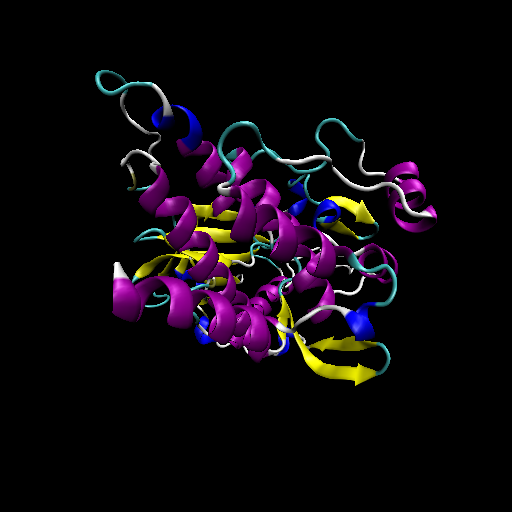 |
 Free energy of binding of drugs to wild type and mutant tpye of KIT Free energy of binding of drugs to wild type and mutant tpye of KIT |
| Gene symbol | Drug name | Free energy of binding (kcal/mol) of wild type | Free energy of binding (kcal/mol) of mutant type | KIT | Sunitinib | -8.6 | -8.6 |
 Relative protein structure stability change (ΔΔE) using Mupro 1.1 Relative protein structure stability change (ΔΔE) using Mupro 1.1 Mupro score denotes assessment of the effect of mutations on thermodynamic stability. (ΔΔE<0: mutation decreases stability, ΔΔE>0: mutation increases stability) |
 : nsSNV at non-LBS : nsSNV at non-LBS : nsSNV at LBS : nsSNV at LBS |
 |
 nsSNVs sorted by the relative stability change of protein structure by each mutation nsSNVs sorted by the relative stability change of protein structure by each mutation Blue: mutations of positive stability change. and red : the most recurrent mutation for this gene. |
| LBS | AAchange of nsSNV | Relative stability change | E640 | S639P | 0.40233581 | L783 | A781T | 0.24001132 | F811 | F811I | 0.23257353 | L647 | L647H | -1.480273 | W557 | V559A | -1.4521665 | D677 | L679F | -1.3162962 | W557 | W557R | -1.2556808 | F811 | G812V | -0.92042216 | A599 | A599T | -0.78172517 | V654 | V654A | -0.76824671 | L783 | A784T | -0.73163061 | L799 | I798F | -0.64864113 | N797 | I798F | -0.64864113 | V603 | V603D | -0.64324169 | W557 | Q556R | -0.61586138 | L595 | T594A | -0.53969341 | W557 | K558R | -0.53275141 | V643 | K642N | -0.52167113 | W557 | K558E | -0.50908041 | V643 | K642E | -0.11964547 |
| (MuPro1.1: Jianlin Cheng et al., Prediction of Protein Stability Changes for Single-Site Mutations Using Support Vector Machines, PROTEINS: Structure, Function, and Bioinformatics. 2006, 62:1125-1132) |
 Structure image for KIT from PDB Structure image for KIT from PDB |
| PDB ID | PDB title | PDB structure | 1PKG | Structure of a c-Kit Kinase Product Complex |  |
| Top |
| Differential gene expression and gene-gene network for KIT |
 Differential gene expression between mutated and non-mutated LBS samples in all 16 major cancer types Differential gene expression between mutated and non-mutated LBS samples in all 16 major cancer types |
| KIT_COAD_DE |
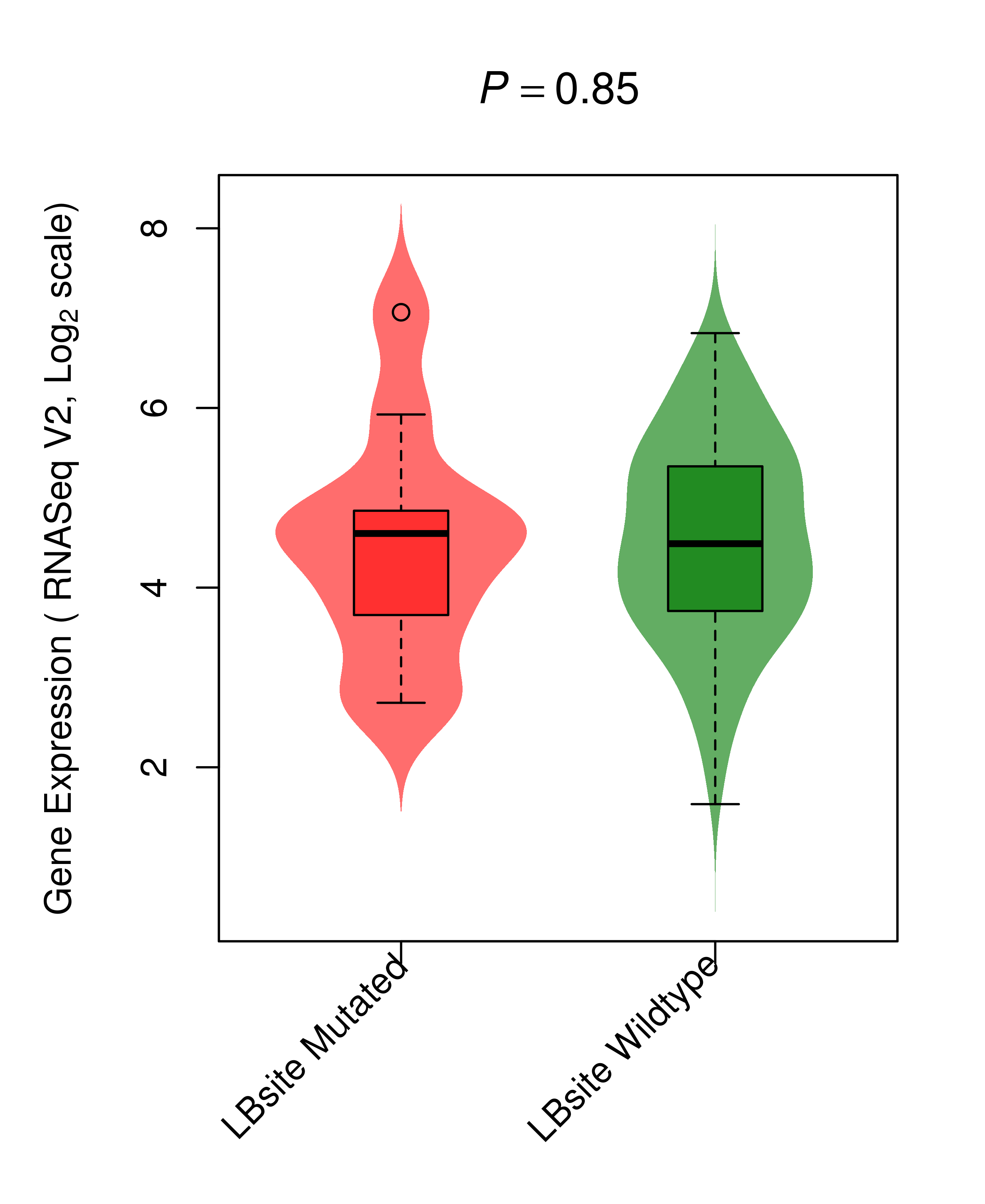 |
 Differential co-expressed gene network based on protein-protein interaction data (CePIN) Differential co-expressed gene network based on protein-protein interaction data (CePIN) |
| * In COAD | |
 |
|
| Top |
| Top |
| Phenotype information for KIT |
 Gene level disease information (DisGeNet) Gene level disease information (DisGeNet) |
| Disease ID | Disease name | # PubMed | Association type |
| umls:C0238198 | Gastrointestinal Stromal Tumors | 621 | AlteredExpression, Biomarker, GeneticVariation |
| umls:C0023467 | Leukemia, Myeloid, Acute | 116 | AlteredExpression, Biomarker, GeneticVariation |
| umls:C0221013 | Mastocytosis, Systemic | 75 | Biomarker, GeneticVariation |
| umls:C0149925 | Small Cell Lung Carcinoma | 24 | AlteredExpression, Biomarker |
| umls:C0080024 | Piebaldism | 22 | Biomarker, GeneticVariation |
| umls:C0023461 | Leukemia, Mast-Cell | 13 | Biomarker, GeneticVariation, PostTranslationalModification |
| umls:C0027643 | Neoplasm Recurrence, Local | 4 | Biomarker, GeneticVariation |
| umls:C1458155 | Breast Neoplasms | 2 | AlteredExpression, Biomarker |
| umls:C1336708 | Testicular Germ Cell Tumor | 2 | Biomarker |
| umls:C0024115 | Lung Diseases | 2 | Biomarker |
| umls:C0684337 | Neuroectodermal Tumors, Primitive, Peripheral | 2 | Biomarker |
| umls:C0153594 | Testicular Cancer | 2 | Biomarker, GeneticVariation |
 Mutation level pathogenic information (ClinVar annotation) Mutation level pathogenic information (ClinVar annotation) |
| Allele ID | AA change | Clinical significance | Origin | Phenotype IDs |
| 28904 | V559A | Pathogenic | Germline | - |
| 28905 | K642E | Pathogenic | Germline | - |
| Top |
| Pharmacological information for KIT |
 Gene expression profile of anticancer drug treated cell-lines (CCLE) Gene expression profile of anticancer drug treated cell-lines (CCLE)Heatmap showing the correlation between gene expression and drug response across all the cell-lines. We chose the top 20 among 138 drugs.We used Pearson's correlation coefficient. |
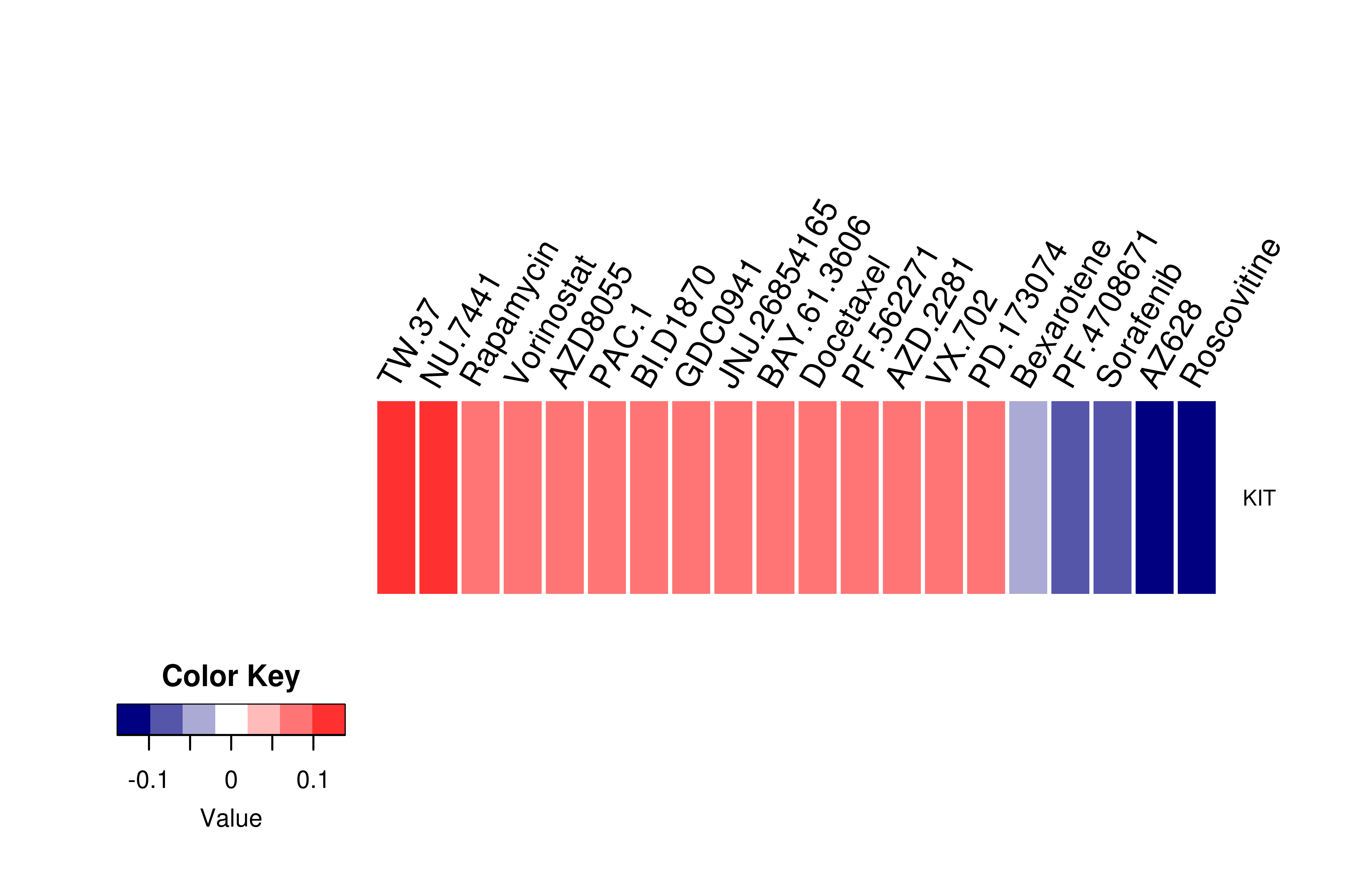 |
 Gene-centered drug-gene interaction network Gene-centered drug-gene interaction network |
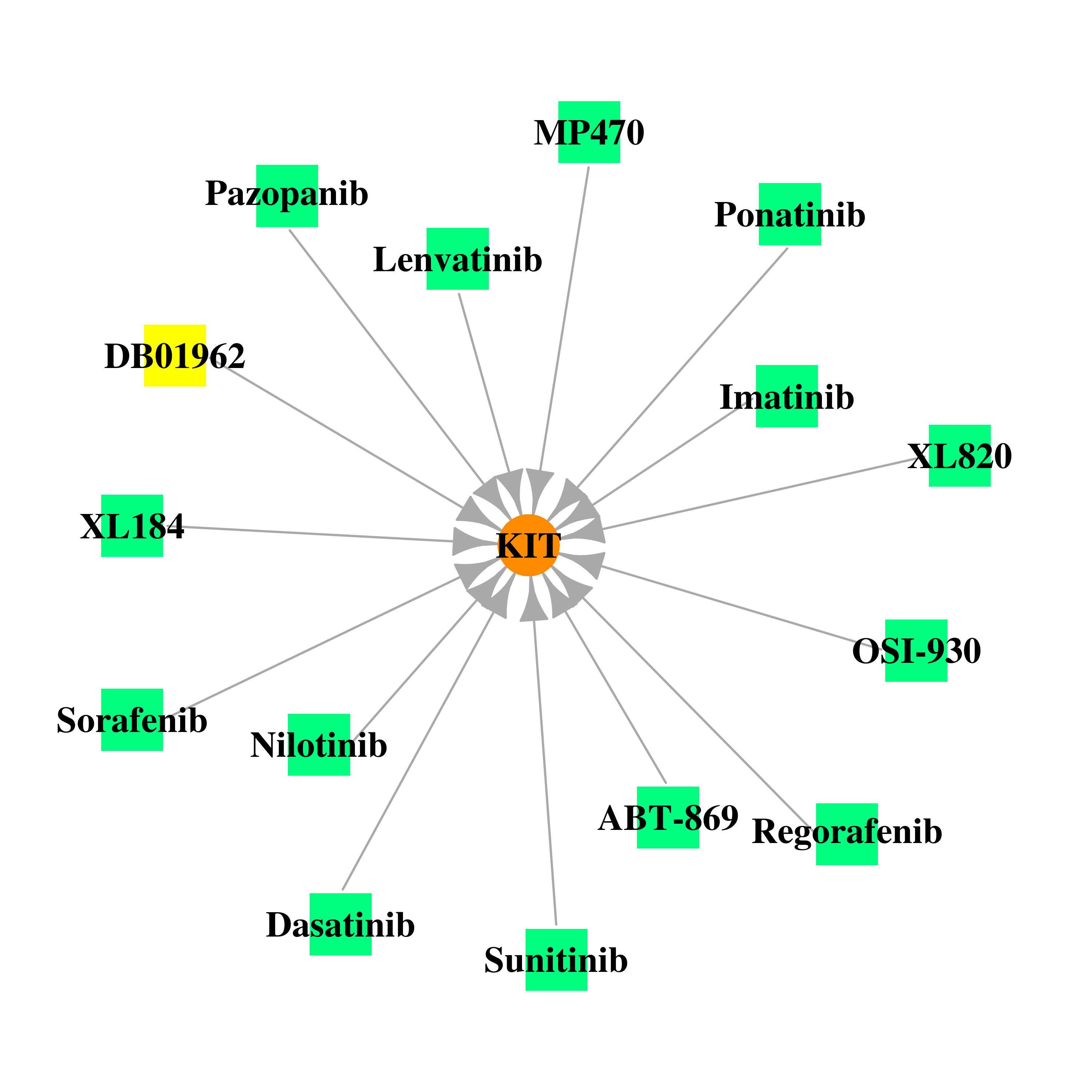 |
 Drug information targeting mutLBSgene (Approved drugs only) Drug information targeting mutLBSgene (Approved drugs only) |
| Drug status | DrugBank ID | Name | Type | Drug structure |
| Approved|investigational | DB00398 | Sorafenib | Small molecule | 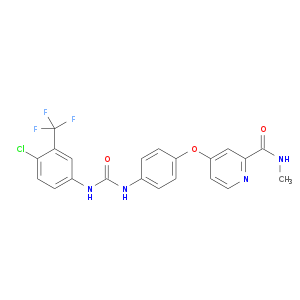 |
| Approved | DB00619 | Imatinib | Small molecule |  |
| Approved|investigational | DB01254 | Dasatinib | Small molecule | 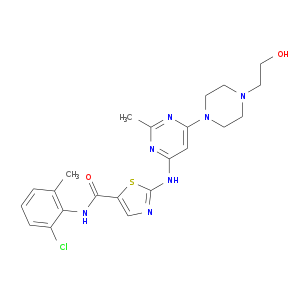 |
| Approved|investigational | DB01268 | Sunitinib | Small molecule | 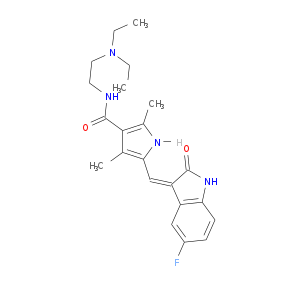 |
| Experimental | DB01962 | Phosphonotyrosine | Small molecule | 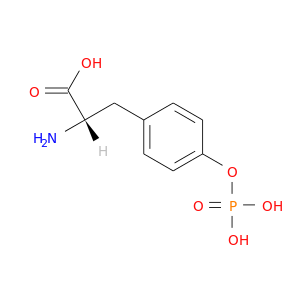 |
| Approved|investigational | DB04868 | Nilotinib | Small molecule | 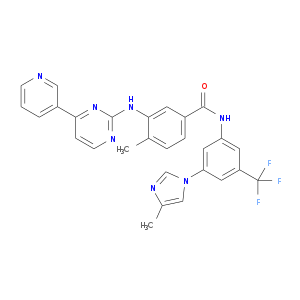 |
| Investigational | DB05146 | XL820 | Small molecule |  |
| Investigational | DB05153 | XL184 | Small molecule |  |
| Investigational | DB05216 | MP470 | Small molecule |  |
| Investigational | DB05913 | OSI-930 | Small molecule |  |
| Investigational | DB06080 | ABT-869 | Small molecule |  |
| Approved | DB06589 | Pazopanib | Small molecule |  |
| Approved | DB08896 | Regorafenib | Small molecule | 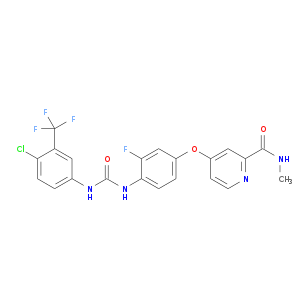 |
| Approved | DB08901 | Ponatinib | Small molecule | 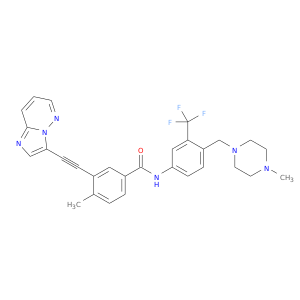 |
| Approved | DB09078 | Lenvatinib | Small molecule |  |
 Gene-centered ligand-gene interaction network Gene-centered ligand-gene interaction network |
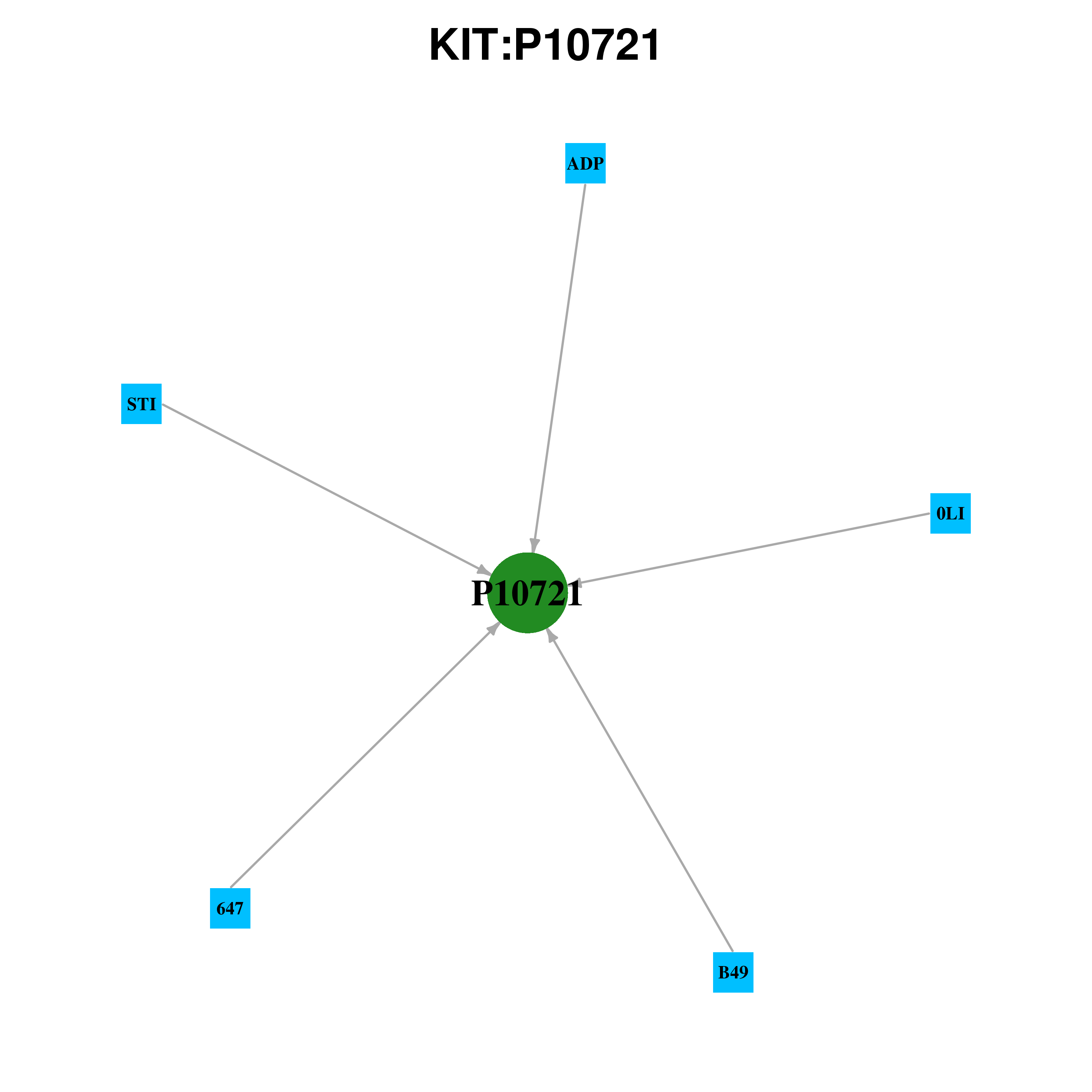 |
 Ligands binding to mutated ligand binding site of KIT go to BioLip Ligands binding to mutated ligand binding site of KIT go to BioLip |
| Ligand ID | Ligand short name | Ligand long name | PDB ID | PDB name | mutLBS | ADP | ADP | 1pkg | A | A599 V603 D677 N797 L799 | ADP | ADP | 1pkg | B | L595 A599 V603 D677 N797 L799 | 0LI | PONATINIB | 4u0i | A | L595 E640 L647 V654 L799 F811 | STI | IMATINIB | 1t46 | A | L595 V603 E640 V643 L799 F811 | B49 | SUNITINIB | 3g0e | A | L595 V603 L799 F811 | B49 | SUNITINIB | 3g0f | A | L595 V603 L799 F811 | B49 | SUNITINIB | 3g0f | B | L595 V603 L799 F811 | MG | MAGNESIUM(2+) | 1pkg | A | N797 | MG | MAGNESIUM(2+) | 1pkg | B | N797 | 647 | 5-(1H-PYRROLO[2,3-B]PYRIDIN-3-YLMETHYL)-N-[4- (TRIFLUOROMETHYL)BENZYL]PYRIDIN-2-AMINE | 4hvs | A | W557 L595 V603 E640 V654 L783 L799 F811 |
| Top |
| Conservation information for LBS of KIT |
 Multiple alignments for P10721 in multiple species Multiple alignments for P10721 in multiple species |
| LBS | AA sequence | # species | Species | A597 | GKTLGAGAFGK | 4 | Homo sapiens, Gallus gallus, Mus musculus, Canis lupus familiaris | A597 | GKTLGSGAFGK | 1 | Danio rerio | A599 | TLGAGAFGKVV | 4 | Homo sapiens, Gallus gallus, Mus musculus, Canis lupus familiaris | A599 | TLGSGAFGKVV | 1 | Danio rerio | A621 | AAMTVAVKMLK | 4 | Homo sapiens, Gallus gallus, Mus musculus, Canis lupus familiaris | A621 | TVMTVAVKMLK | 1 | Danio rerio | C673 | VITEYCCYGDL | 4 | Homo sapiens, Gallus gallus, Mus musculus, Canis lupus familiaris | C673 | VITEYCCFGDL | 1 | Danio rerio | C674 | ITEYCCYGDLL | 4 | Homo sapiens, Gallus gallus, Mus musculus, Canis lupus familiaris | C674 | ITEYCCFGDLL | 1 | Danio rerio | C788 | LASKNCIHRDL | 5 | Homo sapiens, Danio rerio, Gallus gallus, Mus musculus, Canis lupus familiaris | C809 | RITKICDFGLA | 4 | Homo sapiens, Gallus gallus, Mus musculus, Canis lupus familiaris | C809 | RVAKICDFGLA | 1 | Danio rerio | D677 | YCCYGDLLNFL | 4 | Homo sapiens, Gallus gallus, Mus musculus, Canis lupus familiaris | D677 | YCCFGDLLNFL | 1 | Danio rerio | D810 | ITKICDFGLAR | 4 | Homo sapiens, Gallus gallus, Mus musculus, Canis lupus familiaris | D810 | VAKICDFGLAR | 1 | Danio rerio | E376 | IRYVSELHLTR | 2 | Homo sapiens, Canis lupus familiaris | E376 | -SYTSELKLVR | 1 | Danio rerio | E376 | NSYTSELHLTR | 1 | Gallus gallus | E376 | IRYVNQLRLTR | 1 | Mus musculus | E640 | EALMSELKVLS | 5 | Homo sapiens, Danio rerio, Gallus gallus, Mus musculus, Canis lupus familiaris | E671 | TLVITEYCCYG | 4 | Homo sapiens, Gallus gallus, Mus musculus, Canis lupus familiaris | E671 | TLVITEYCCFG | 1 | Danio rerio | F600 | LGAGAFGKVVE | 4 | Homo sapiens, Gallus gallus, Mus musculus, Canis lupus familiaris | F600 | LGSGAFGKVVE | 1 | Danio rerio | F811 | TKICDFGLARD | 4 | Homo sapiens, Gallus gallus, Mus musculus, Canis lupus familiaris | F811 | AKICDFGLARD | 1 | Danio rerio | G596 | FGKTLGAGAFG | 4 | Homo sapiens, Gallus gallus, Mus musculus, Canis lupus familiaris | G596 | FGKTLGSGAFG | 1 | Danio rerio | G598 | KTLGAGAFGKV | 4 | Homo sapiens, Gallus gallus, Mus musculus, Canis lupus familiaris | G598 | KTLGSGAFGKV | 1 | Danio rerio | G601 | GAGAFGKVVEA | 4 | Homo sapiens, Gallus gallus, Mus musculus, Canis lupus familiaris | G601 | GSGAFGKVVEA | 1 | Danio rerio | G676 | EYCCYGDLLNF | 4 | Homo sapiens, Gallus gallus, Mus musculus, Canis lupus familiaris | G676 | EYCCFGDLLNF | 1 | Danio rerio | H378 | YVSELHLTRLK | 2 | Homo sapiens, Canis lupus familiaris | H378 | YTSELKLVRLK | 1 | Danio rerio | H378 | YTSELHLTRLK | 1 | Gallus gallus | H378 | YVNQLRLTRLK | 1 | Mus musculus | H790 | SKNCIHRDLAA | 5 | Homo sapiens, Danio rerio, Gallus gallus, Mus musculus, Canis lupus familiaris | I653 | GNHMNIVNLLG | 3 | Homo sapiens, Mus musculus, Canis lupus familiaris | I653 | GNHINIVNLLG | 2 | Danio rerio, Gallus gallus | I789 | ASKNCIHRDLA | 5 | Homo sapiens, Danio rerio, Gallus gallus, Mus musculus, Canis lupus familiaris | I808 | GRITKICDFGL | 4 | Homo sapiens, Gallus gallus, Mus musculus, Canis lupus familiaris | I808 | GRVAKICDFGL | 1 | Danio rerio | K623 | MTVAVKMLKPS | 5 | Homo sapiens, Danio rerio, Gallus gallus, Mus musculus, Canis lupus familiaris | L595 | SFGKTLGAGAF | 4 | Homo sapiens, Gallus gallus, Mus musculus, Canis lupus familiaris | L595 | RFGKTLGSGAF | 1 | Danio rerio | L644 | SELKVLSYLGN | 5 | Homo sapiens, Danio rerio, Gallus gallus, Mus musculus, Canis lupus familiaris | L647 | KVLSYLGNHMN | 3 | Homo sapiens, Mus musculus, Canis lupus familiaris | L647 | KVLSYLGNHIN | 2 | Danio rerio, Gallus gallus | L783 | KGMAFLASKNC | 3 | Homo sapiens, Mus musculus, Canis lupus familiaris | L783 | KGMDFLASKNC | 1 | Danio rerio | L783 | KGMSFLASKNC | 1 | Gallus gallus | L799 | AARNILLTHGR | 4 | Homo sapiens, Gallus gallus, Mus musculus, Canis lupus familiaris | L799 | AARNILLTQGR | 1 | Danio rerio | N797 | DLAARNILLTH | 4 | Homo sapiens, Gallus gallus, Mus musculus, Canis lupus familiaris | N797 | DLAARNILLTQ | 1 | Danio rerio | R791 | KNCIHRDLAAR | 5 | Homo sapiens, Danio rerio, Gallus gallus, Mus musculus, Canis lupus familiaris | R796 | RDLAARNILLT | 5 | Homo sapiens, Danio rerio, Gallus gallus, Mus musculus, Canis lupus familiaris | T670 | PTLVITEYCCY | 4 | Homo sapiens, Gallus gallus, Mus musculus, Canis lupus familiaris | T670 | PTLVITEYCCF | 1 | Danio rerio | V603 | GAFGKVVEATA | 5 | Homo sapiens, Danio rerio, Gallus gallus, Mus musculus, Canis lupus familiaris | V622 | AMTVAVKMLKP | 4 | Homo sapiens, Gallus gallus, Mus musculus, Canis lupus familiaris | V622 | VMTVAVKMLKP | 1 | Danio rerio | V643 | MSELKVLSYLG | 5 | Homo sapiens, Danio rerio, Gallus gallus, Mus musculus, Canis lupus familiaris | V654 | NHMNIVNLLGA | 3 | Homo sapiens, Mus musculus, Canis lupus familiaris | V654 | NHINIVNLLGA | 2 | Danio rerio, Gallus gallus | V668 | GGPTLVITEYC | 5 | Homo sapiens, Danio rerio, Gallus gallus, Mus musculus, Canis lupus familiaris | W557 | MYEVQWKVVEE | 3 | Homo sapiens, Mus musculus, Canis lupus familiaris | W557 | KYQIQWKVIEG | 1 | Danio rerio | W557 | KYEVQWKVVEE | 1 | Gallus gallus | Y672 | LVITEYCCYGD | 4 | Homo sapiens, Gallus gallus, Mus musculus, Canis lupus familiaris | Y672 | LVITEYCCFGD | 1 | Danio rerio |
 |
Copyright © 2016-Present - The University of Texas Health Science Center at Houston |

